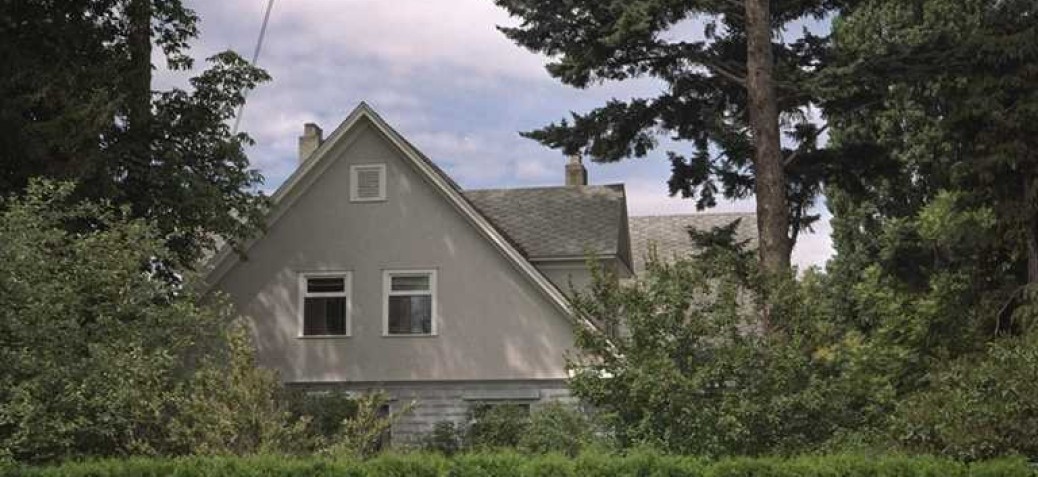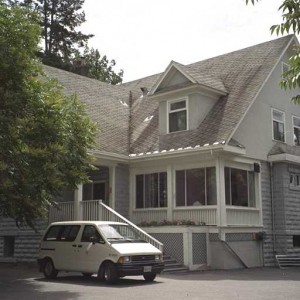Cadder House (Oak Lodge)
Place Description
The historic place is the large, two-storey, concrete-block Cadder House (also known as Oak Lodge), built in 1908, and situated at 2124 Pandosy Street in the Abbott Street Heritage Conservation Area in Kelowna's South Central neighbourhood.
Heritage Value
The building has heritage value for its association with the Kelowna's significant tree-fruit industry, through two former residents, and with health care services, through two institutional uses. It also has value for its architecture and its stature, reported to have been the largest private residence in Kelowna when it was built.
Cadder House was built for Thomas Willing (T.W.) Stirling, who was prominent in the tree-fruit industry and other lines of business. Although descended from Scottish landed gentry, Stirling was born in England. In 1879, at the age of 13, he entered the Royal Navy as a cadet. He rose to the rank of lieutenant and resigned his commission in 1893. A year later he came to Kelowna with his wife Mabel and children. He purchased a portion of the old Nicolson property, which he renamed 'Bankhead'. He built a large house and orchard there and maintained purebred livestock. In 1905 Stirling became president of the BC Fruit Growers' Association.
With ample capital and great energy, Stirling became involved in almost every agricultural enterprise in the area. He and James Crozier were the prime movers in the organization of the Okanagan's first agricultural cooperative marketing organization, the Kelowna Shippers' Union. When that failed, Stirling founded the independent shipping firm of Stirling and Pitcairn. He put up much of the capital for the Kelowna Land and Orchard Company, which purchased and subdivided the Lequime estate and started the large-scale orchard development of East Kelowna. (The house of W.R. Pooley, an original partner and promoter of the company, stands at 3690 Pooley Road.)
Stirling also invested in the Kelowna Sawmill Company and was the backer of the Okanagan Loan and Investment Trust Company (280 Bernard Avenue), which provided financing to fruit growers. He was also a generous donor to community projects, such as the Kelowna Hospital and St. Michael and All Angels Anglican Church.
When World War I broke out, Stirling returned to the Royal Navy. He worked on the movement of transports and convoys, and rose to the rank of Commander, becoming decorated with the Order of the British Empire. After the war he returned briefly to Kelowna, but in 1921 returned permanently to the family estate (Muiravonside) in Scotland, which he had inherited after the death of his older brother.
Stirling built 'Cadder House' (named after Cadder in Lanarkshire, the family's original seat) in 1908, moving here from Bankhead. It was reportedly the largest residence in Kelowna when built, and one of the few houses in the young city that might be termed a 'mansion'. The house is 1.5 storeys high, with a medium-pitch gable roof. The lower portion is rendered in rusticated concrete block. The front grounds extended to Cadder Avenue, and a greenhouse and hotbeds stood behind.
Cadder House was used as the Hospital's nurses' residence from 1922 to 1924. After T.W. Stirling's death in 1930, it was purchased by Byron McDonald. In 1913 McDonald had established B.C. Growers Ltd., an independent fruit-shipping house, and in 1923 he established another, B.C. Orchards Ltd. He acquired the orchard of the Kelowna Land and Orchard Company, which he incorporated under the name of Keloka Orchards Ltd. McDonald had other local business interests as well, opening a garage in 1925 on Bernard Avenue and investing in mines at Beaverdell. He became involved in civic politics, sitting on City Council from 1929 to 1932.
After McDonald's death in 1936, Cadder House passed through several hands. It eventually passed into institutional use. In 1964 it was set up as a senior citizens' facility under the name of 'Oak Lodge', later functioning as a psychiatric care facility. Cadder House (Oak Lodge) remains a large and prominent structure. A current proposal to be addressed in 2004 proposes a conversion to a number of dwelling units within the building.
Character Defining Elements
- The largest residence in Kelowna when built
- Foundation and ground floor rendered in locally manufactured (Haug) rusticated concrete block
- Cross-gabled design
- Simple, classically-inspired symmetrical front elevation
- Prominent porch under cross gable
- Gabled, medium-pitched main roof with several small gabled pedimented dormers
- Small square bay projecting on right side
- Large lot with many trees, including oak, pine, and fir






